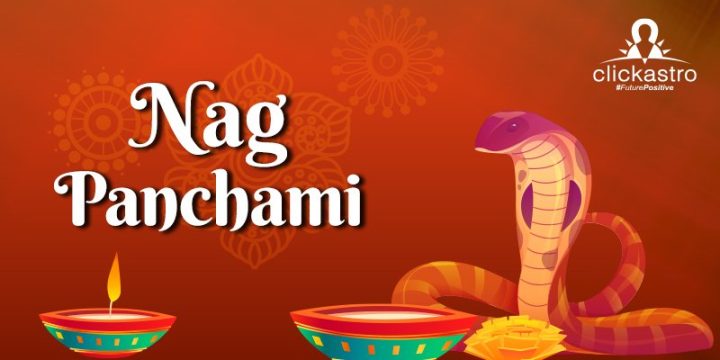Nag Panchami
The word ‘naga’, in general, means snake, and in particular, means cobra. During Naga Panchami, snake gods are worshipped and milk is offered to them. Naga Panchami falls on the fifth day of the waxing phase of the moon, during the month of Shravan. This occasion is celebrated with great fervor by the people across India. Naga Panchami is popular for worshipping snakes as superlative deities. It holds a big place in ancient Vedic history.
Nag Panchami is equally important to devotees of both Lord Vishnu and Lord Shiva. Lord Vishnu reclines on Sheshnag as he floats across the endless cosmic ocean. Sheshnag is the king of nagas. People offer milk to snakes during Nag Panchami in his honor. This is done to protect themselves and their families from the threat of snakes. The occasion holds a significant meaning for the devotees of Lord Shiva also. The month of Shravan in itself is dedicated to Lord Shiva as snakes play a vital part in his life. Shiva devotees offer flowers, rice, and milk to snakes and pray for their blessing during Nag Panchami.
When is Naga Panchami 2024?
Nag Panchami is on Friday, August 9, 2024
Nag Panchami Puja Muhurat – 06:18 am to 08:52 am
Duration – 2 hours and 34 minutes.
Nag Pancham date in Gujarat – Friday, August 23, 2024
Panchami Tithi Begins – 12:36 AM, August 9, 2024
Panchami Tithi Ends – 03:14 AM, August 10, 2024
Significance of Nag Panchami
Snakes are both feared and revered in Vedic culture. It is considered auspicious if a snake comes to the house during the occasion of Nag Panchami. Also, any type of plowing and tilling is to be avoided as it may disturb the snakes. Because of their association with Lord Shiva and Lord Vishnu, there are many temples built in honor of snakes. People across India perform various poojas and rituals to earn their goodwill. A special kind of music is played while haldi, kumkum, and flowers are used for decorations.
Why Do People Offer Milk to Snakes?
It is well known that snakes do not drink milk. If they do, it is due to dehydration more than anything else. Yet, every year, many thousands of people offer milk to snakes as part of worshipping the Naga Devata. People perform this ritual out of the belief that it would protect them and their families from evil energies and misfortunes. Snakes are seen as divine deities and the ritual is aimed at gaining their blessings.
The history behind the Celebration Naga Panchami
The history of Nag Panchami has its roots in Mahabharata. Taksaka, the chief of the Naga clan had a long-held enmity with the family of Arjuna, who had tried to end his clan by burning down the forest where they lived along with other tribes. Later, Arjuna’s grandson, King Parikshit was cursed by the son of a sage that he would die by snake bite. It was Taksaka who fulfilled that curse. He bit Parikshit and slew him while he was meditating on Lord Vishnu. In revenge, King Janamejaya, son of Parikshit, fought a war and expelled the nagas headed by Taksaka from Takshasila, where they had been residing. Not content, Janamejaya then started a campaign to exterminate the Naga race.
Taksaka then escaped to the Deva territory where he sought protection from King Indra. But Janamejaya’s men traced him and arrested him. Just when Taksaka and the other Naga chiefs were to be executed, a learned sage named Astika arrived and interfered on behalf of the Nagas. His mother Jaratkaru (Manasa) was a Naga. Janamejaya had to listen to the words of the learned Astika and set Taksaka free. He also stopped the massacre of the Nagas and ended all the enmity with them. From then onwards, the Nagas and Kurus lived in peace. This occasion is celebrated as Naga Panchami ever since.
Another story related to Nag Panchami involves Lord Krishna. To kill the child Krishna, King Kamsa sent the poisonous snake Kaliya. While Krishna was playing with his friends, the ball went into the river. When Krishna entered the river to retrieve it, Kaliya attacked. A fierce battle followed, at the end of which, Krishna defeats Kaliya. This occasion of the victory of good over evil is also celebrated as Nag Panchami.
Celebration and Rituals of Nag Panchami
Naga Panchami has numerous rituals. On this day, women place an image of a snake made out of cow dung at the doorstep. Following prayer, kusha grass, milk, akshat, and sandalwood are offered to the snake. Special offerings are made in the form of cooked vermicelli (Sevai), ladoo, and kheer. It is believed that worshipping the snakes of Chamatkarpur can fulfill all the wishes. Milk is generously used in the delicacies prepared at home on this day.
This festival has special importance in certain parts of Bharath like Ujjain and Gujarat. Thousands of devotees throng the Mahakaleshwar Mandir of Ujjain during Naga Panchami. Idols of Sheshnag are bathed with milk and worshipped. People pray for paradise and freedom on this day.
Astrological Reasons behind the Naga Panchami Celebration
According to
Vedic astrology, besides Yoga, there are Doshas also to be considered. The Kal Sarpa Dosha is one of the most potent and most feared Dosha in Kundali. This happens when the ill effects of Rahu and Ketu overwhelm those other planets. Worshipping Sheshnag and snakes on the day of Naga Panchami offer redemption from the Kal Sarpa Dosha. Also, offering a pair of snakes made of silver to the Shiva lingam can mitigate the ill effects of this dosha.
Interesting features of Nag Panchami
Observing fast on Nag Panchami is a common practice. Plowing the earth or cutting shrubs is not allowed on this day. This is to ensure that no snakes are harmed. It is a way to open up the mind to respecting and embracing all forms of life. No iron utensils are used in the kitchen on this day.
The most obvious reason for celebrating the festival of Nag Panchami is to gain protection from snakes. There is tremendous rainfall during the month of Shravan. Snakes in their burrows are forced out by rising water levels. They may bite humans in self-defense. So, on this day, snakes are fed milk. It is believed that snakes remember the humans it comes in contact with. The whole exercise is to please the snakes and prevent their attack.
There is also a story connecting Nag Panchami with Samudra Manthan. During Samudra Manthan, Lord Shiva drank all the poison that came out from the churning of the sea. But a few drops fell on the ground and were drunk by snakes. This is another reason why snakes are worshipped during Nag Panchami.







